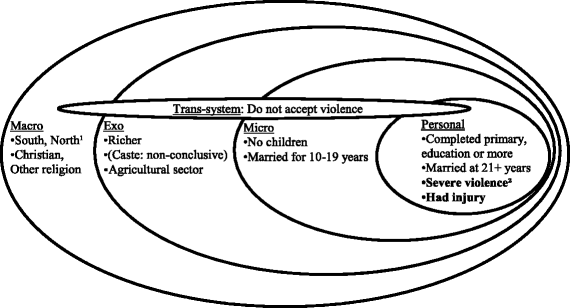Prevalence and predictors of help-seeking for women exposed to spousal violence in India - a cross-sectional study
- PMID: 29100538
- PMCID: PMC5670508
- DOI: 10.1186/s12905-017-0453-4
Prevalence and predictors of help-seeking for women exposed to spousal violence in India - a cross-sectional study
Abstract
Background: Spousal violence against women is prevalent in India (29%). Studies from various countries have shown that few women exposed to intimate partner violence or spousal violence seek help, especially in low-income countries. The objective of this study was to estimate the prevalence and predictors of help-seeking among women in India who have experienced various types of spousal violence.
Methods: Cross-sectional data on 19,125 married, separated, divorced or widowed women in India who had experienced physical or sexual violence at the hands of their husbands were obtained from the India National Family Health Survey III 2005-2006. Bivariate and multivariate logistic regression analyses were carried out.
Results: Less than one fourth (23.7%) of married, separated, divorced or widowed women in India who had experienced some form of physical or sexual spousal violence had sought help, but only 1% had sought help from formal institutions. Help-seeking was most prevalent in women who had been exposed to a combination of physical, sexual and emotional abuse (48.8%) and the least prevalent in women who had experienced sexual violence only (1.5%). Experience of severe violence and violence resulting in injury were the strongest predictors of help-seeking. Having education, being Christian or an acknowledged adherent of another minority religion - mainly Buddhism and Sikhism (Islam not included), getting married after the age of 21 and living in the South region were also associated with seeking help. Women in the North and Northeast regions were less likely to seek help, as were women with children and women who thought that a husband could be justified in hitting his wife.
Conclusions: Very few Indian women who experience spousal violence seek help. The characteristics of the violence are the strongest predictors of help-seeking, but sociodemographic factors are also influential. We recommend efforts to ensure educational attainment for girls, prevention of child marriages, and that police officers and health care staff should be educated about intimate partner violence and in how to respond to women who seek help. It is important to tackle norms and attitudes surrounding violence against women, as well as attitudes to women who disclose violence.
Keywords: Ecological model; Help-seeking; India; Predictors; Prevalence; Spousal violence.
Conflict of interest statement
Ethics approval and consent to participate
The NFHS-3 survey was approved by the Ministry of Health & Family Welfare, Government of India and the International Institute of Population Sciences (IIPS) was the nodal agency responsible for the survey. Informed consent was obtained from all study participants before participation and all information was collected confidentially.
Consent for publication
Not applicable.
Competing interests
The authors declare that they have no competing interests.
Publisher’s Note
Springer Nature remains neutral with regard to jurisdictional claims in published maps and institutional affiliations.
Figures
Similar articles
-
Physical, emotional and sexual violence faced by spouses in India: evidence on determinants and help-seeking behaviour from a nationally representative survey.J Epidemiol Community Health. 2020 Sep;74(9):732-740. doi: 10.1136/jech-2019-213266. Epub 2020 Jun 2. J Epidemiol Community Health. 2020. PMID: 32487566
-
Exploring spousal disparities: Age, earnings, and education as predictors of intimate partner violence in 29 developing countries.Womens Health (Lond). 2024 Jan-Dec;20:17455057241310289. doi: 10.1177/17455057241310289. Womens Health (Lond). 2024. PMID: 39707898 Free PMC article.
-
Disclosure and help seeking behavior of women exposed to physical spousal violence in Dhaka slums.BMC Public Health. 2016 May 10;16:383. doi: 10.1186/s12889-016-3060-7. BMC Public Health. 2016. PMID: 27165579 Free PMC article.
-
Public health impact of marital violence against women in India.Indian J Med Res. 2019 Dec;150(6):525-531. doi: 10.4103/ijmr.IJMR_1427_19. Indian J Med Res. 2019. PMID: 32048616 Free PMC article. Review.
-
Intimate partner violence in Sri Lanka: a scoping review.Ceylon Med J. 2015 Dec;60(4):133-8. doi: 10.4038/cmj.v60i4.8100. Ceylon Med J. 2015. PMID: 26778392
Cited by
-
Help-seeking behaviors and determinant factors among women exposed to intimate partner violence in East Africa based on recent demographic and health survey data: a multilevel analysis.Front Psychiatry. 2024 Sep 26;15:1402704. doi: 10.3389/fpsyt.2024.1402704. eCollection 2024. Front Psychiatry. 2024. PMID: 39391082 Free PMC article.
-
Prevalence, pattern, and predictors of formal help-seeking for intimate partner violence against women: findings from India's cross-sectional National Family Health Surveys-3 (2005-2006) and 4 (2015-2016).BMC Public Health. 2022 Dec 20;22(1):2386. doi: 10.1186/s12889-022-14650-3. BMC Public Health. 2022. PMID: 36536339 Free PMC article.
-
Barriers to Help-Seeking for Domestic Violence in Kyrgyzstan: Perspectives of Criminal Justice, Social, Health, and Educational Professionals.Glob Soc Welf. 2022 Sep;9(3):179-192. doi: 10.1007/s40609-022-00226-x. Epub 2022 Jun 9. Glob Soc Welf. 2022. PMID: 37293550 Free PMC article.
-
Prevalence of domestic violence against women in informal settlements in Mumbai, India: a cross-sectional survey.BMJ Open. 2020 Dec 16;10(12):e042444. doi: 10.1136/bmjopen-2020-042444. BMJ Open. 2020. PMID: 33328262 Free PMC article.
-
Influence of type of violence on women's help-seeking behaviour: Evidence from 10 countries in sub-Saharan Africa.PLoS One. 2024 Mar 8;19(3):e0297308. doi: 10.1371/journal.pone.0297308. eCollection 2024. PLoS One. 2024. PMID: 38457385 Free PMC article.
References
-
- World Health Organization (WHO). Global and regional estimates of violence against women: prevalence and health effects of intimate partner violence and non-partner sexual violence. Geneva: WHO; 2013. http://www.who.int/reproductivehealth/publications/violence/978924156462....
-
- García-Moreno C, Jansen HAFM, Ellsberg M, Heise L, Watts C. WHO multi-country study on Women’s health and domestic violence against women. Geneva: WHO; 2005. http://www.who.int/reproductivehealth/publications/violence/9241593512/en/.
-
- Ellsberg M, Jansen HAFM, Heise L, Watts CH, García-Moreno C. Intimate partner violence and women’s physical and mental health in the WHO multi-country study on women’s health and domestic violence: an observational study. Lancet. 2008;371:1165–72. - PubMed
MeSH terms
LinkOut - more resources
Full Text Sources
Other Literature Sources


